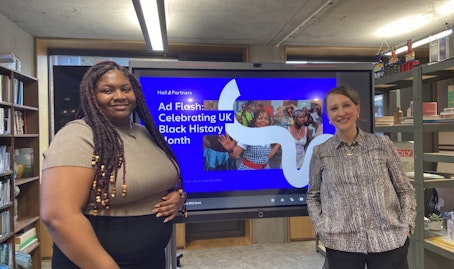Perspectives

At Hall & Partners and C Space, part of Escalent Group, we’ve always believed that great advertising deserves more than applause—it deserves reflection. Ads are small cultural mirrors, prisms through which we glimpse how people see the world, and how the world sees them back. They reveal who holds the narrative, whose voices get heard and, just as importantly, whose don’t. But they also hold power—the power to shift how we think, how we feel and how we relate to one another. Ads don’t just reflect society, they can reshape it. That’s the spark behind Ad Flash, our ongoing global series where teams dissect creative work to uncover why it resonates, divides or disappears.
Our latest session, hosted by Belinda Ikwuwunna from our Black Belonging Resource Group and open to colleagues across regions, explored how inclusive marketing and representation in advertising are evolving worldwide. Through a cultural intelligence lens, we unpacked what’s working, what’s not and what audiences now expect from brands.
Across dozens of campaigns, four distinctive themes emerged that show where the next frontier of inclusive creativity truly lies.
1. Redemption and repair: Fixing fast matters more than feigning perfection
Even purpose-led brands stumble. What separates the sincere from the performative is how fast—and how transparently—they course-correct.
Dove (UK/US) offers one of the most striking examples. Its 2023 partnership with Pinterest tackled algorithmic bias by letting users shape beauty content around their own realities—a powerful evolution from its 2017 misstep implying a Black woman was “cleaned” into a white one. Redemption, in Dove’s case, has meant years of sustained accountability.
H&M (Sweden/Global) followed a similar arc. After its “coolest monkey in the jungle” scandal, the brand rebuilt credibility through collaborations with Black creators and London-based photographers celebrating real, everyday communities.
And in 2025, Nike (US) took the concept of repair literally with its FlyEase campaigns—co-designed with athletes with disabilities and launched across Japan and Australia—proving that listening deeply and redesigning authentically is the real fix.
At the other end of the spectrum, Sanex (UK) faced backlash. The Advertising Standards Authority (ASA) upheld two complaints which said the depiction of dark skin as dry, cracked and itchy “could be interpreted as suggesting that white skin was superior to black skin”.
The takeaway: Redemption isn’t a press release or an apology; it’s progress in inclusive advertising that audiences can see and trust.
2. Authentic representation: How real inclusion looks and feels
Representation in advertising lands hardest when it feels lived, not labelled. John Lewis (UK) nailed this with its centenary film celebrating “Never Knowingly Undersold,” quietly weaving a century of multicultural British life into moments of everyday joy. No tokenism, no declaration—just truth.
Apple (US) carried this ethos into its global “The Greatest” and “Design for Everyone” campaigns that aired across the US, Germany and South Korea, spotlighting users with disabilities living their ordinary, extraordinary lives—no sentimentality, just possibility.
From Brazil, Lush’s “Scent of My Culture” campaign brought together perfumers from Bahia, Kerala and Marrakech, each reimagining home through fragrance. And Djerf Avenue (Sweden/US) staged its inclusive New York runway, featuring models across sizes and abilities—a joyous, unfiltered celebration of how fashion can feel personal and universal at once.
The takeaway: The most powerful inclusive representation doesn’t announce itself—it feels inevitable and authentic.
3. Representation with responsibility: Showing up means backing it up
Representation without reform is a hollow gesture. Audiences can now tell if institutions are transforming—or just tweeting.
Genomics England (UK) mastered this nuance by showing a tender conversation between a grandson and grandmother about health, ancestry and openness—a topic often shrouded in taboo in many African and Caribbean households.
The Metropolitan Police (UK) began to pivot from top-down recruitment appeals to community-centered storytelling—though, as audiences reminded us, true inclusion requires deep structural change, not just new billboards.
In the private sector, LinkedIn’s (Global) #BreakTheBias campaign, launched across India and Canada, tied its inclusive hiring message to actual product design changes that reduce algorithmic bias.
The takeaway: Responsibility means not just saying the message but embedding and living it.
4. Provocative is easy in advertising—Responsible is rare
Inclusion also means knowing when creative confidence slips into cultural carelessness.
American Eagle (US) faced backlash with its Sydney Sweeney “My Genes Are Great” campaign, which many viewers read as racially tone-deaf. But when Gap (US) responded with its playful “Milkshake” counter-campaign featuring Kelis and an intentionally diverse cast, the result was a vibrant reclaiming of joy.
LEGO (Denmark/Global) set an opposite example with its “My Identity, My Brick” initiative, co-created with kids and families worldwide. The campaign built on its A–Z of Awesome project to give shape—literally—to gender and body diversity through play.
And Nike’s “Fear the Lionesses” (UK) outdoor campaign, celebrating the women’s football team, captured confidence without compromise—a fusion of cultural pride and inclusivity built for the moment.
The takeaway: Boldness without cultural literacy is carelessness. The best campaigns don’t avoid risk—they rise to meet it.
From awareness to action: Turning cultural insights into inclusive impact
Ad Flash isn’t really about the ads. It’s about what happens after—the learning, reflection and dialogue that push us all further.
At Escalent Group, inclusion isn’t a project or a principle; it’s our process. Our Cultural Advisory Group, a cross-market collective of specialists whose lived experiences and regional fluency span five continents, helps us ask one essential question in every project: Who’s missing?
It’s the question that shapes how we analyze, advise and collaborate. Because the more perspectives we bring in, the sharper our insights—and the more human our storytelling becomes.
Want to make your brand’s insights as inclusive as your intentions?
We help organizations translate inclusivity into insight—through market research, creative testing and cultural advisory that uncover what real belonging means in practice.
Special thanks to Morris Swaby Ebanks and Belinda Ikwuwunna for their contributions to this blog post!
Let’s connect—and turn inclusion into intelligence.
Meet our authors
Kisha Payton, Chief Belonging & Inclusion Officer, Escalent Group
Neha Mittal, Director, C Space
Talk to our team of experts
Learn how we can deliver actionable insights and creativity to drive brand growth.








